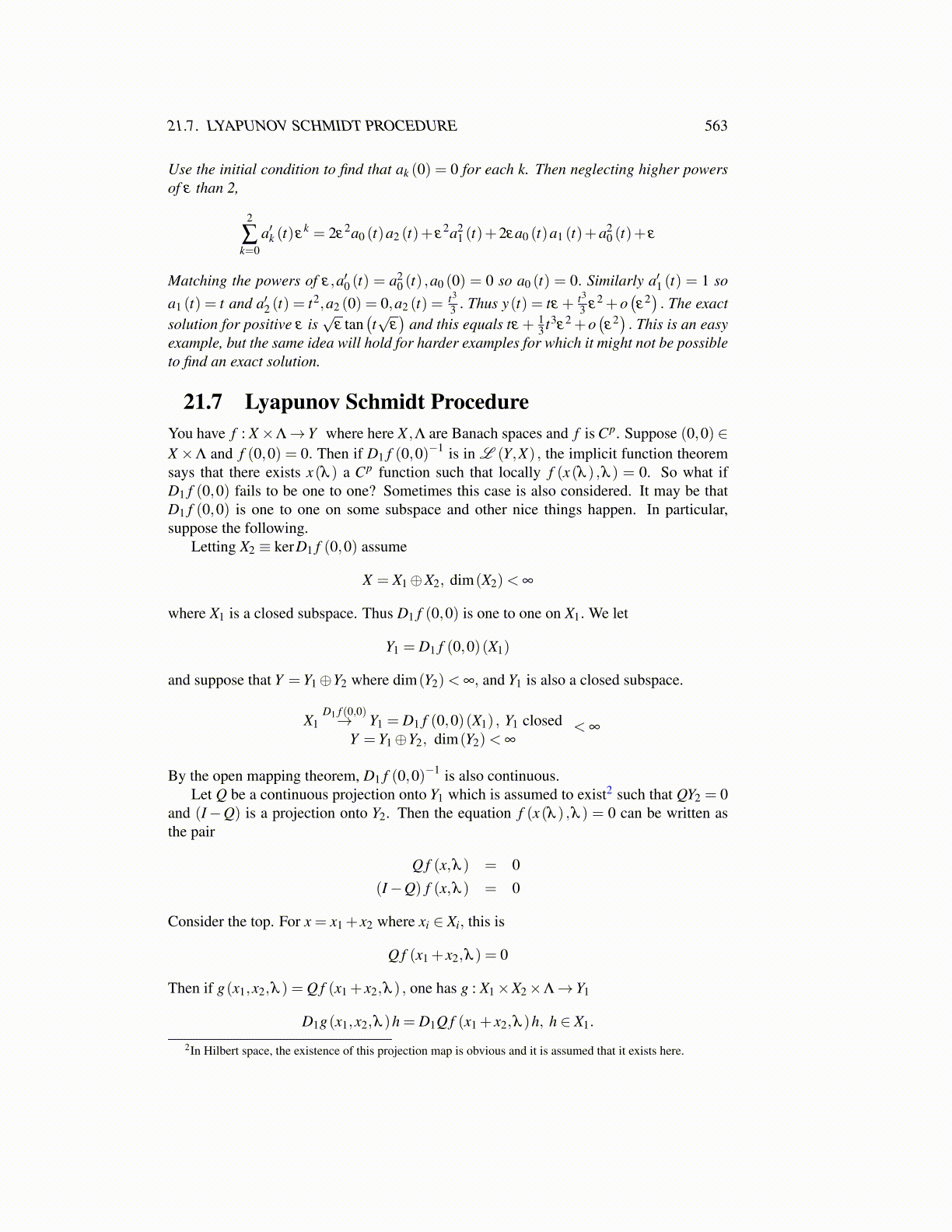
21.7. LYAPUNOV SCHMIDT PROCEDURE 563
Use the initial condition to find that ak (0) = 0 for each k. Then neglecting higher powersof ε than 2,
2
∑k=0
a′k (t)εk = 2ε
2a0 (t)a2 (t)+ ε2a2
1 (t)+2εa0 (t)a1 (t)+a20 (t)+ ε
Matching the powers of ε,a′0 (t) = a20 (t) ,a0 (0) = 0 so a0 (t) = 0. Similarly a′1 (t) = 1 so
a1 (t) = t and a′2 (t) = t2,a2 (0) = 0,a2 (t) = t3
3 . Thus y(t) = tε + t3
3 ε2 +o(ε2). The exact
solution for positive ε is√
ε tan(t√
ε)
and this equals tε + 13 t3ε2 +o
(ε2). This is an easy
example, but the same idea will hold for harder examples for which it might not be possibleto find an exact solution.
21.7 Lyapunov Schmidt ProcedureYou have f : X×Λ→Y where here X ,Λ are Banach spaces and f is Cp. Suppose (0,0) ∈X ×Λ and f (0,0) = 0. Then if D1 f (0,0)−1 is in L (Y,X) , the implicit function theoremsays that there exists x(λ ) a Cp function such that locally f (x(λ ) ,λ ) = 0. So what ifD1 f (0,0) fails to be one to one? Sometimes this case is also considered. It may be thatD1 f (0,0) is one to one on some subspace and other nice things happen. In particular,suppose the following.
Letting X2 ≡ kerD1 f (0,0) assume
X = X1⊕X2, dim(X2)< ∞
where X1 is a closed subspace. Thus D1 f (0,0) is one to one on X1. We let
Y1 = D1 f (0,0)(X1)
and suppose that Y = Y1⊕Y2 where dim(Y2)< ∞, and Y1 is also a closed subspace.
X1D1 f (0,0)→ Y1 = D1 f (0,0)(X1) , Y1 closed
Y = Y1⊕Y2, dim(Y2)< ∞< ∞
By the open mapping theorem, D1 f (0,0)−1 is also continuous.Let Q be a continuous projection onto Y1 which is assumed to exist2 such that QY2 = 0
and (I−Q) is a projection onto Y2. Then the equation f (x(λ ) ,λ ) = 0 can be written asthe pair
Q f (x,λ ) = 0(I−Q) f (x,λ ) = 0
Consider the top. For x = x1 + x2 where xi ∈ Xi, this is
Q f (x1 + x2,λ ) = 0
Then if g(x1,x2,λ ) = Q f (x1 + x2,λ ) , one has g : X1×X2×Λ→ Y1
D1g(x1,x2,λ )h = D1Q f (x1 + x2,λ )h, h ∈ X1.
2In Hilbert space, the existence of this projection map is obvious and it is assumed that it exists here.